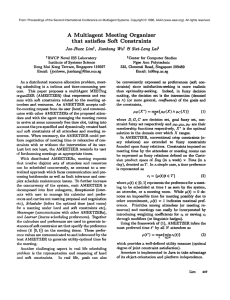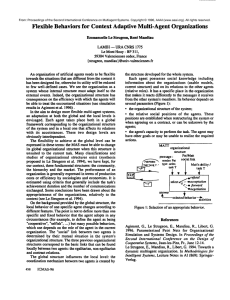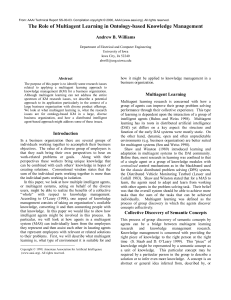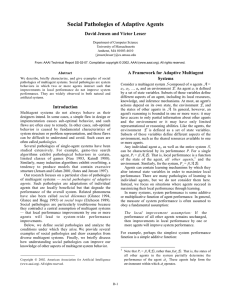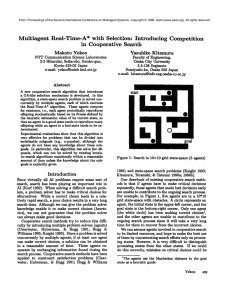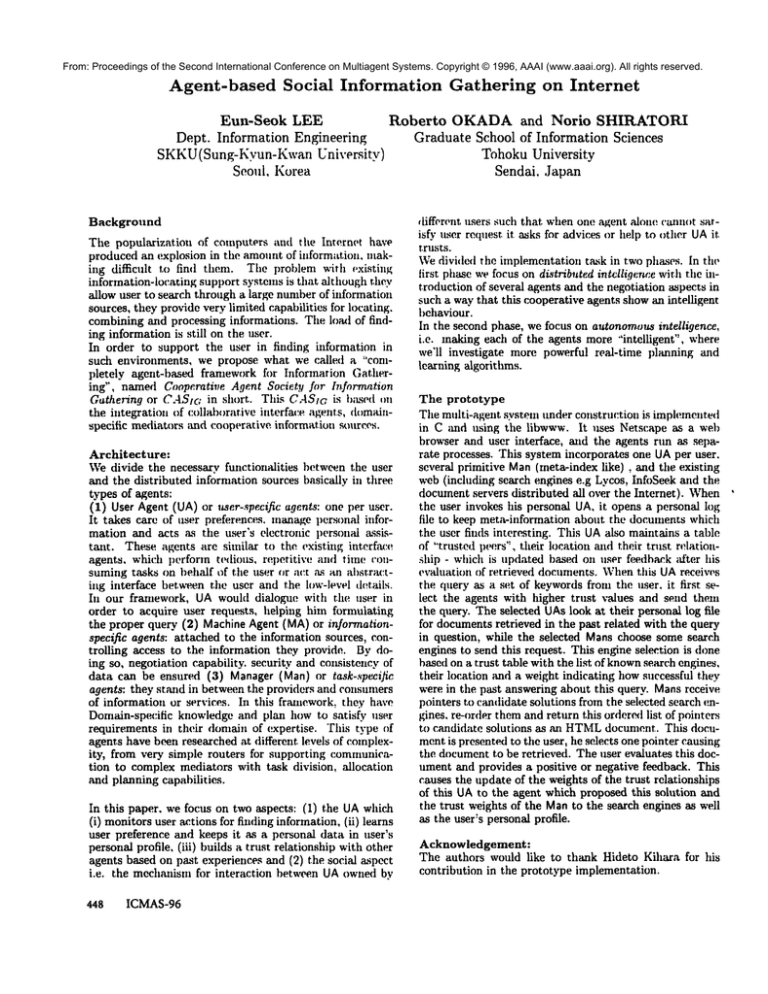
From: Proceedings of the Second International Conference on Multiagent Systems. Copyright © 1996, AAAI (www.aaai.org). All rights reserved.
Agent-based
Social
Information
Gathering
on Internet
Eun-Seok LEE
Roberto OKADAand Norio SHIRATORI
Dept. InformationEngineering
GraduateSchool of InformationSciences
SKKU(Sung-Kyun-Kwan
University)
TohokuUniversity
Seoul, Korea
Sendal. ,Japan
Background
The popularization of computers and the Internet have
produced an explosion in the amountof inform~ttion, ntaking difficult to find the.hi. The. problem with oxisting
information-locating support systemns is that ahhoughthey
allow user to search througha large, nunfl)e.r of information
sources, they provide very limited capabilitie.s for locating.
combiningand processing informations. The load of finding informationis still on the user.
In order to support the user in finding information in
such environments, we propose, what we called a "completely agent-based framework for Information Gathering", named Cooperative Agent Society for In.formation
GatheT~ngor CASte: in short. This CASIa is b;Lsed on
the integration of collaborative, interface agents, domainspecific mediators and cooperative informatiou ~mrces.
difforent users such that whenone agent alone cannot satisfy user request it asks for advices or help to other IJA it
trusts.
Wedivide.d the impleme.ntation task in two phases. In the
tirst phase, wefocus on distributed intelligence with the introduction of several agents and the negotiation aspects in
such a way. that this cooperative agents showan intelligent
bchaviour.
In the second phase, we focus on autonomousintelligence,
i.e. makingeach of the agents more "’intelligent", where
we’ll investigate more powerful real-time planning and
le.arning algorithms.
The prototype
The multi-alAent system under construction is implemented
in C and using the libwww. It uses Netscape as a web
browser and user interface, mxdthe agents run ‘as separate processes. This system incorporates one UAper user.
Architecture:
Wedivide
thenecessary
functionalities
between
the.user several primitive Man(meta-index like) , and the existing
andthedistributed
information
sources
basically
in three web(including search engines e.g Lycos, Inh)Seek and the
types
ofagents:
documentservers distributed all over the Internet). When
the. user invokes his personal UA,it opens a personal log
(1) User Agent(UA)u,ser-specific agents: one. per user.
It takes care. of user preferences, managepersonal inforfile. to keep meta-information about the documentswhich
mation and acts ,as the user’s electronic personal ~ssisthe user flints interesting. This UAalso maintains a talfle
of "trusted peers", their location and their trust relationtmtt. Theseage.nts are. sinfilar to the existing interface
ship - which is updated based on user feedback ~ffter his
agents, which perform tedious, repetitive and time consumingtasks on behalf of the user or act ,as an abstractevaluation of retrieved documents. Whenthis UAreceiw,s
ing interface bet~.en the. user and the low-level details.
the query as a set of keywordsfrom the. user, it first seIn our framework, UAwouhl dialogue, with the user in
lect the agents with higher trust values and send them
order to acquire user reque.sts, helping him fornmlating
the query. The selected UAslook at their per~nal log file
for documentsretrieved in the past related with the query
the proper query (2) Machine Agent (MA)inf ormationspecific agents: attached to the information sources, conin question, while the selected Manschoose somesearch
engines to send this request. This engine selection is done.
trolling access to the information they provide. By dobase.d on a trust tahle with the list of knownsearch engines,
ing so, negotiation capability, security and consistency of
their location and a weight indicating howsuccessful they
data can be ensured (3) Manager (Man}tas k-specific
agents: they stand in betweenthe. provide.rs and consumers
were in the past answering about this query. Mansreceive
pointers to candidate solutions from the selected search enof information or services. In this franmwork,they have
Domain-specific knowledgeand plan howto satisfy user
gine.s, re.-order themandreturn this orde.red list of pointers
requirements in their domain of expertise. This type of
to candidate, solutions as an HTML
document. This doeuagents have been researched at different levels of complexme.at is presentedto the user, he selects one pointer causing
ity, from ve~" simple routers for supporting communicathe documentto be retrieved. The user evaluates this doction to complexmediators with task division, ,allocation
ument and provides a positive or negative feedback. This
and planning capabilities.
causes the update of the weights of the trust relationships
of this UAto the agent which proposed this solution and
Inthispaper,
we focuson twoaspects:
(I)theUA wlfich the trust weights of the Manto the search engines as well
(i)monitors
useractions
forfinding
information,
(ii)learns as the user’s personalprofile.
userpreference
andkeepsit as a personal
datainuser’s
personal
profile,
(iii)
builds
a trust
relationship
withother Acknowledgement:
agents
basedonpastexperiences
and(2)the.social
aspect The authors would like to tllank Hideto Kihara for his
contribution in the prototype implementation.
i.e. the mechanismfor interaction between UAowned by
448 ICMAS-96
From: Proceedings of the Second International Conference on Multiagent Systems. Copyright © 1996, AAAI (www.aaai.org). All rights reserved.
A Multiagent Meeting Organizer
that satisfies
Soft Constraints
Joo-Hwee Lira t,
JiankangWut ~f~
tRWCPNovel ISS Laboratory
Institute of Systems Science
IIeng Mui Keng Terrace, Singapore 119597
Email: (joohwee, jiankang}@iss.nus.sg
As a distrihuted resour(~ allocation problem, meeting sdmduling is a tedious and time-consuming process. This paper proposes a multiAgent MEETing
organiZER (AMEETZER)that respresents
and reasons with soft constraints related to the meeting att~mdees and resources. An AMEETZER
accepts callfor-meeting
request
fron|itsuser(host)
andconmmnicateswithotherAMEETZERsof the proposedattendeesand withthe agentmanagingthe meetingrooms
to arriveat somecommonly
freetimeslot,takinginto
~u:count
thepre-specified
anddynmnically
created
hard
andsoftconstraints
of allattendees
andmeeting
resources.Whcn necessar);the AMEETZERcouldperformnegotiation
of mc~.ting
timeor relaxation
of constraints
withor without
theintervention
of itsuser.
Lastbut not least,the AMEETZERremindsits user
of forthcondng meetings aC appropriate times.
With distrihuted
AMEETZERs,meeting requests
that involve disjoint se.ts of attendees and resources
can be scheduled concurrently, as contrast to a centralized approadl which faces conmnmication and procrossing bottlenecks as well as fanlt tolerance mid complex scheduh., maintemmceissues. To filrther increase
the concurrency of the system, eacJl AMEETZER
is
dc~composedinto four subagents, Receptionist (inter~:ts with user to manage his calendar and prefercnces and can’ies out meeting proposal and negotiation
ctc), Scheduler (infers the optimal time (and room)
for a meeting under hard and .soft constraints etc),
Messenger (connmmic:~tes with other AMEETZERs),
and Learner (learns scheduling preferences). Together
the calendm’s and preferences are used to g~merate instmme.sof soft constraint set that specify the preferv.nce
-~tlues (E [0, l]) on the meeting times. These prefi~.r
once values are conmnmicatedto and inferenced by the
host AMEETZER
to generate utility-optimal
time for
the meeting.
Another challenging asl)eCt in real life scheduling
l~rohlem is the representation mid reasoning of hard
and soft constraints.
In real life, goal.s can also
Siet-Leng
Lag
~Center for ComputerStudies
Ngee Ann Polytechnic
535, Clementi Road, Singapore 599489
Email: lsl@np.ac.sg
be conveniently expressed as preferrences (soft constraints) since satisfaction-seeking is more realistic
than optimality-seeking.
Indeed, in fuzzy decision
making, the decision set is the intersection (denoted
as A) (or more general, confluence) of the goals and
the constraints,
ItDCX’) = m~xb,G(X) ^ t,c(X)}
0)
where D, G, C are decision set, goal fuzzy set, constraint filzzy set respectively and I~D,PC,, PCare ttmir
membership fimctions respectively, X" is the optimal
solution in tim domain over whic~ X ranges.
In AMEETZER,
conventional crisp constraints (nary relations)
are extended to fuzzy constraints
founded upon filzzy relations. Constraints imposed on
meeting time by the attendees or meeting rooms can
be expressed as filzzy relations defined on the Cartesian product space of Day (in a week) x Time (in
day), denoted as T. In a simple case, a time preference
is represented as
ci = {l,(t)lt
(2)
E
whereI~(t) ¯ [0, 1] represents the preference for a meeting to be scheduled at time t as seen by the system,
an attendee., or a meeting room. While l~(t) = 0 denotes ml impossible time for meeting possibly due to
other commitment, l~(t) = 1 indicates maximal preference. Priorities
among attendees (or meeting resources) and meetings can easily be incorporated by
introducing weighting coefiieients for ci or sieving ci
through modifiers (or linguistic hedges).
Using the framework of (1), AMEETZER
infers the
most preferred time t" by all N attendees as
(3)
I,(t’) = max/train
ci(t)}
t -i_~N
whic]| provides a we.U-defined utility measure (optimal
degree of joint constraint satisfaction).
Ameetzer is implemented in Java to take advantage
of its object-orientation anti platform independence.
Lira
449

